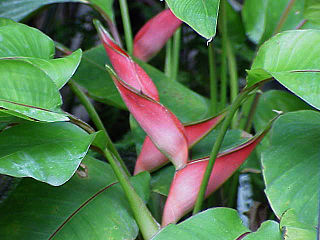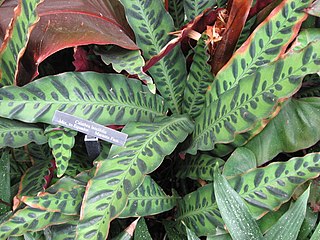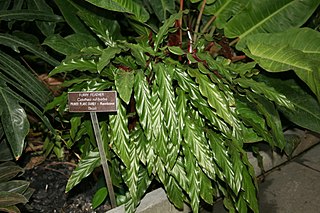
The Marantaceae are a family, the arrowroot family, or the prayer plant family, of flowering plants consisting of 31 genera and around 530 species, defining it as one of the most species-rich families in its order. Species of this family are found in lowland tropical forests of Africa, Asia, and the Americas. The majority (80%) of the species are found in the American tropics, followed by Asian (11%) and African (9%) tropics. They are commonly called the prayer-plant family and are also known for their unique secondary pollination presentation.

Heliconia stricta is a plant species native to Brazil, Colombia, Venezuela, Ecuador, Peru, Bolivia, Guyana, Suriname, reproducing by seeds and by underground rhizomes. It is reportedly naturalized in Cuba and Puerto Rico, and cultivated as an ornamental in many other warm regions. The young leaves and bracts retain water, forming pools called phytotelmata, which provide habitat for diverse invertebrates.

Chrysalidocarpus lutescens, also known by its synonym Dypsis lutescens and as golden cane palm, areca palm, yellow palm, butterfly palm, or bamboo palm, is a species of flowering plant in the family Arecaceae, native to Madagascar and naturalized in the Andaman Islands, Thailand, Vietnam, Réunion, El Salvador, Cuba, Puerto Rico, the Canary Islands, southern Florida, Haiti, the Dominican Republic, Jamaica, the Leeward Islands and the Leeward Antilles. Its native names are rehazo and lafahazo.

Phytotelma is a small water-filled cavity in a terrestrial plant. The water accumulated within these plants may serve as the habitat for associated fauna and flora.
Goeppertia curaraya is a species of flowering plant in the Marantaceae family. It is native to Ecuador and Colombia. Its natural habitat is subtropical or tropical moist lowland forests.
Goeppertia dodsonii is a species of flowering plant in the Marantaceae family. It is endemic to Ecuador. Its natural habitat is subtropical or tropical moist lowland forests.

Goeppertia ecuadoriana is a species of flowering plant in the Marantaceae family. It is endemic to Ecuador. Its natural habitats are subtropical or tropical moist lowland forests and subtropical or tropical moist montane forests.
Goeppertia gandersii is a species of flowering plant in the Marantaceae family. It is endemic to Napo Province of Ecuador. Its natural habitats are subtropical or tropical moist lowland forests and subtropical or tropical moist montane forests.
Goeppertia libbyana is a species of flowering plant in the family Marantaceae, endemic to Napo Province of Ecuador. Its natural habitat is subtropical or tropical moist lowland forests. It has gained the Royal Horticultural Society's Award of Garden Merit.

Goeppertia veitchiana is a species of flowering plant in the Marantaceae family. It is endemic to Ecuador. Its natural habitats are subtropical or tropical moist lowland forests and subtropical or tropical moist montane forests.

Goeppertia makoyana, also known as peacock plant or cathedral windows, is a species of plant belonging to the genus Goeppertia in the family Marantaceae, native to Espírito Santo state of eastern Brazil. It has gained the Royal Horticultural Society's Award of Garden Merit.

Goeppertia loeseneri, the Brazilian star calathea, is a species of plant belonging to the Marantaceae family. It is native to Peru, northern Brazil, Colombia, and Ecuador. It can grow to a height of 1.2m.

Goeppertia insignis, the rattlesnake plant, is a species of flowering plant in the Marantaceae family, native to Rio de Janeiro state in Brazil.

Goeppertia is a genus of flowering plants in the family Marantaceae, native to the New World Tropics. It contains 243 accepted species, many of which were until recently assigned to Calathea. It was first described by Nees von Esenbeck in 1831, who erroneously erected another genus Goeppertia in 1836, which has now been synonymized with Endlicheria. In 1862 August Grisebach described another genus Goeppertia; this has now been synonymized with Bisgoeppertia.

Maranta leuconeura, widely known as the prayer plant due to its daily sunlight-dependent movements, is a species of flowering plant in the family Marantaceae native to the Brazilian tropical forests. It is a variable, rhizomatous perennial, growing to 30 cm (12 in) tall and broad, with crowded clumps of evergreen, strikingly-marked oval leaves, each up to 12 cm (5 in) long. The plant spreads itself horizontally, carpeting an entire small area of forest floor, sending roots into the substrate at each leaf node.

Calathea lutea, called the bijao, cigar calathea, Cuban cigar, Mexican cigar plant, Habana cigar, and pampano, is a species of flowering plant in the family Marantaceae. It is native to southern Mexico, Central America, southern Caribbean islands, and tropical South America. A rhizomatous perennial reaching 3 m (10 ft), it is typically found in wet tropical areas. Its leaves are sold for use in local cuisines as food wrappers, and it is also used as an ornamental.
Goeppertia elegans is a plant species belonging to the family Marantaceae native to Colombia and Panama. It resembles Goeppertia cuneata.

Goeppertia rufibarba, the furry feather or velvet calathea, is a species of flowering plant in the Marantaceae family, native to Bahia state of northeastern Brazil. The plant's common names are due to its fuzzy, fur-like underleaf texture, which is unusual in its genus. Common as a houseplant, the species requires warm temperatures, shade, and humidity to thrive, and may produce small yellow flowers. It has gained the Royal Horticultural Society's Award of Garden Merit.

Goeppertia roseopicta is a species of flowering plant in the arrowroot and prayer-plant family Marantaceae, native to northwestern Brazil's Amazonian basin. Oftentimes, it is marketed as a houseplant under its former generic name and synonym Calathea roseopicta. It is a clump-forming, evergreen perennial, growing to 50 cm (20 in), and is very similar in appearance to G. makoyana. The typical "wild-type", or "natural" form, has papery, ovate leaves of a pastel, seafoam-green hue, outlined with a dark-green edging and "painted" horizontally from the midribs with darker streaks; typical of other species in its family and genus, G. roseopicta features dark reddish, purplish backsides to its foliage, an evolutionary adaptation to growing in darkened or shaded areas on the forest floor, where adequate light reflection is required for photosynthesis.

Goeppertia fasciata, is a species of flowering plant in the family Marantaceae. Native to wet tropical areas of northeastern Brazil, it is occasionally kept as a houseplant. There appears to be a cultivar, 'Borrusica'.













